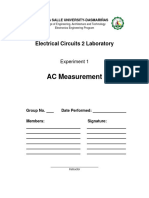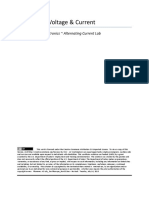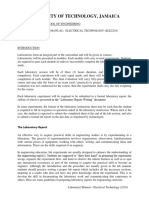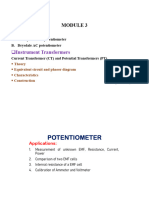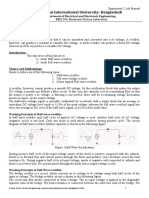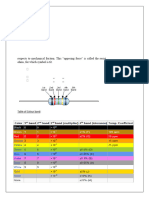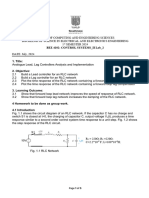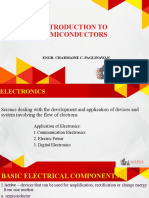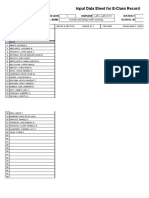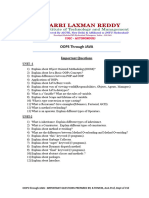Experiment 1
Experiment 1
Uploaded by
Kenneth SablayCopyright:
Available Formats
Experiment 1
Experiment 1
Uploaded by
Kenneth SablayCopyright
Available Formats
Share this document
Did you find this document useful?
Is this content inappropriate?
Copyright:
Available Formats
Experiment 1
Experiment 1
Uploaded by
Kenneth SablayCopyright:
Available Formats
MAPUA UNIVERSITY
School of Electrical Electronics and Computer Engineering
Electronics 1 Laboratory
ELECTRONIC COMPONENTS
AND LABORATORY EQUIPMENT
Sablay, Kenneth Bryan M.
Name of Student
2018109635 ME-2 ECE20L-2 – E05
Student Number Program-Year Course-Section
Group Number Group Members
8/20/2021 8/27/2021
Date Performed Date Submitted
Grade
Professor Ernesto Vergara Jr.
Course Instructor
ELECTRONIC COMPONENTS
AND LABORATORY EQUIPMENT
1. Objectives
The objectives of this activity are: familiarize the students with the operation of the
following equipment: oscilloscope, function generator and digital multi-meter (DMM); and
understand how resistor and capacitor values are measured.
2. List of Laboratory Instruments
1 pc Oscilloscope 1 pc Oscilloscope test probe
1 pc Function generator 1 pc Function generator probe alligator cable
1 pc Digital multi-meter (DMM) 1 pc Component board
3. Introductory Information
Resistors
A resistor is a device whose major function is to limit the amount of current in a circuit.
The unit of resistance is the Ohm (). This device is available in a very wide range of
values, from a fraction of an Ohm to many mega-Ohm. The power rating may be as high
as several hundred Watt or as low as milli-Watt.
There are two types of resistors, the fixed and the variable. A fixed resistor has a specific
value of resistance that cannot be adjusted while a variable resistor or potentiometer can
be adjusted for any value between zero Ohm and its maximum value. A control or a knob
is connected to the device to set its equivalent resistance.
The value of a fixed resistor can be determined by using the color coding.
Capacitors
A capacitor consists of two conductors separated by an insulator or dielectric. This device
is able to store electric charge in the dielectric because free electrons cannot flow through
Electronics 1 Laboratory – Electronic Components and Laboratory Equipment 2
this material. However, the charge must be applied by a voltage source. This process is
called charging the capacitor. The charging continues until the potential difference across
the capacitor is equal to the applied potential. Charge flows into the conductors and remains
there even when the source is removed. It will start to discharge once a conducting path is
provided between the plates, and this will continue until the capacitor voltage drops to zero.
The charge stored depends on the capacitance of capacitor, which is measured in Farad (F).
Types of capacitors
Non-electrolytic capacitor
Classified according to the dielectric,
most common are air, mica, paper and ceramic
Small capacitance - about 10 pF to 1 F
No polarity and can take a fairly high voltage
Variable capacitor
Value is adjustable
Usually called trimmers or padders
Used in tuners
Electrolytic capacitor
Large capacitance – about 1 F to 50,000 F
+ - Must be connected with proper polarity
Low voltage rating - about 25 V
It has a significant leakage current,
this means that it will lose the charge stored after a while
Tantalum capacitor
A type of electrolyticcapacitor
+ - that uses tantalum instead of aluminum
Physically smaller, has lower leakage,
and is more expensive
Electronics 1 Laboratory – Electronic Components and Laboratory Equipment 3
The Digital Multi-meter
A multi-meter is an electronic measuring instrument that combines several functions in one
unit. The most basic functions include an ammeter, voltmeter, and ohmmeter. An ammeter
measures current, a voltmeter measures the potential difference (voltage) between two
points, and an ohmmeter measures resistance.
There are two types of multi-meters, the analog and the digital multi-meter (DMM). An
analog multi-meter moves a needle along a scale while a digital multi-meter gives an output
in numbers, usually on a liquid crystal display.
Take note of the following when doing measurements:
1. Before making any measurement, wait for 30 seconds after turning on the meter.
2. Set the rotary switch to the function you want to use before connecting the probes
to a voltage or current source.
3. Always disconnect the test leads from the voltage or current source before selecting
a new function.
4. Do not measure current levels above 10A longer than 30 seconds.
5. When testing components, first turn off the power in the circuit or component being
tested. Otherwise, you may not get an accurate reading and may damage the DMM.
6. When measuring current, the DMM must be connected in series, not parallel.
The Function Generator
The function generator is an apparatus that delivers sinusoidal, triangular, and rectangular
waveforms. It has a frequency meter that measures and displays the output frequency.
The Oscilloscope
The oscilloscope is a device that is capable of drawing a graph of an electrical signal. The
graph shows the changes and characteristics of the signal, y-axis represents voltage and the
x-axis represents time.
Oscilloscopes are of two types – the analog and the digital. For many applications, either
an analog or digital oscilloscope will do. However, each type has unique characteristics
that may make it more or less suitable for specific applications.
Electronics 1 Laboratory – Electronic Components and Laboratory Equipment 4
Basically, the oscilloscope is capable of measuring the following parameters:
Frequency – is measured in Hertz (Hz) and equals the number of times the signal repeats
itself in one second, referred to as cycles per second.
Period – is amount of time it takes the signal to complete one cycle. Period and frequency
are reciprocals of each other, so that 1/period equals the frequency and 1/frequency equals
the period.
Voltage – refers to the amount of electric potential or signal strength between two points
in a circuit.
4. Procedure
Objective A. Identify and measure resistance and capacitance values.
A1. Given samples of resistors and capacitors, provide the values of each component by
completing Table 1-1. Read the value or use coding for the computed values and the
digital multi-meter for the measured values.
Table 1-1 Values of Resistors and Capacitors
Tolerance
Component Computed Measured
(if provided)
R1 1.5k Ohms ±10% N/
R2 4.7k Ohms ±5% A
N/
C1 220 nF A
N/
C2 100 nF A
N/
C3 100 uF A
N/
A
Are the values in agreement?
Not
Applicable
Based on the above measurements, are the components in good or bad condition?
Substantiate your answer.
Not
Applicable
Electronics 1 Laboratory – Electronic Components and Laboratory Equipment 5
Objective B. Perform functional check on the oscilloscope.
B1. Turn ON the oscilloscope power source. Upon boot-up, wait for the display to show
that self-tests have passed.
B2. Push the <SAVE/RECALL> button, select [SETUPS] in the top menu box and push
the [Recall Factory] menu box.
B3. Connect the oscilloscope probe to channel 1. Make sure that the attenuation of the
probe and the oscilloscope are the same (use either X1 or X10). Push the CH1
button and select the proper probe attenuation.
B4. Connect the probe tip and reference lead to the PROBE COMP connectors as shown.
Figure 1-1. Oscilloscope Function Check.
B5. Push the <AUTOSET> button. A square wave of approximately 5Vpeak-to-peak
amplitude at a frequency of 1 kHz should be displayed.
B6. Draw the waveform as shown on the screen using Graph 1-1. Record the current
oscilloscope display settings.
Vertical factor = 2 V/div
Vertical divisions = 5
Voltage = V/div x no. of vertical div
= 10 Vpp
Time base setting = 1 s/div
Horizontal divisions = 2
Period = time base setting
x no. of horizontal div
= 2 s
Frequency = 1/Period
=500 Hz
Graph 1-1. Functional Check Waveform
Electronics 1 Laboratory – Electronic Components and Laboratory Equipment 6
B7. Push the CH1 MENU button to turn OFF Channel 1, push the CH2 MENU button
to turn ON Channel 2. Repeat steps B3 to B5, this time using Channel 2. Make a
comparison of the displays using Channels 1 and 2.
Not
Applicable
B8. Leave the oscilloscope ON for the next procedure.
Note: It is important to perform functional check every time the oscilloscope is used.
Objective C. Familiarize the students on the use of the function generator and oscilloscope.
C1. Turn ON the Function Generator. Connect the probe alligator cable to the
OUTPUT BNC socket.
C2. Connect the alligator cable of the Function Generator to the oscilloscope probe. Use
CH1 of the oscilloscope. Set the Function Gen for an output of 1 kHz, 10 Vpp,
sinusoidal wave.
C3. Push the <AUTOSET> button of the oscilloscope. Draw the waveform displayed on
the oscilloscope screen using Graph 1-2 and record the oscilloscope display settings.
Vertical factor = _2 V/div
Vertical divisions = 5
Voltage = V/div x no. of vertical div
= 10 Vpp
Time base setting =1 s/div
Horizontal divisions = 2
Period = time base setting
x no. of horizontal div
=2 ms
Frequency= 1/Period
=500 Hz
Graph 1-2. Output Waveform
C4. To automatically display the values, push the <MEASURE> button. Record the
following readings for Channel 1.
Peak-to-peak = 10 Vpp Period = 2 ms
Frequency = 500 Hz Mean = Not
Cyc RMS = Not Applicable
aApplicable
Electronics 1 Laboratory – Electronic Components and Laboratory Equipment 7
C5. Compute for Vrms using the given formula:
Vrms = ( Vpp / 2 ) * 0.707 =3.535 V
C6. Next, add a multi-meter by connecting the red lead to the tip of the red alligator cable
and the black lead to ground terminal. Measure the AC voltage (Cyc RMS) and
record the reading. Vrms = N/ V
A
Do the rms values in procedures C4, C5 and C6 agree? (consider a ±5% tolerance)
Not
Applicable
Remove the multi-meter.
C7. Push the <CURSOR> button and choose Voltage from the menu using the soft keys,
turn the Position knobs to place the cursors at the peaks of the waveform, as shown
in Figure 1-2 and write the values given on the display.
Cursor 2 Cursor 1 = -5 Vpk
Cursor 2 = 5 Vpk
Delta = 10 Vpk -pk
Cursor 1
Figure 1-2 Voltage Measure using Cursors
Does the value of Delta agree with the Peak-to-Peak value in step C4? Do they have
the same values? Why or why not?
The value of Delta with the Peak-to-Peak value is a match. The value is a match because
the wave is constant and exact, making manual calculations easier
C8. Next, choose Time from the cursor menu using the soft keys, turn the Position knobs
to place the cursors to show one complete cycle, as illustrated in Figure 1-3 and write
the values given on the display.
Cursor 1 = 0 msec
Cursor 2 = -2 msec
Delta = 2 msec
Cursor 2 Cursor 1
Figure 1-3 Time Measure using Cursors
Electronics 1 Laboratory – Electronic Components and Laboratory Equipment 8
Does the value of Delta agree with the Period given in step C4? Do they have the
same values? Why or why not?
The value of Delta with the Period value is a match. The same reasoning as in C7 is also
true for this question.
C9. Turn OFF the cursor to hide the lines.
C10. Write down your observations in Table 1-2 for each procedure:
Table 1-2 Observations on the Use of Oscilloscope and Function Generator
Procedure Observations
Rotate the Volts/Div knob It clips the signal when I set it too low, and the signal is
unreadable when I set it too high.
of the oscilloscope CW
and CCW
When I rotate the sec/div knob clockwise, the number of seconds
Rotate the Sec/Div knob of each division represents will decrease, but when I rotate counter-
the oscilloscope CW and clockwise, it increases the time scale, and it show a longer
CCW amount of time on the screen.
The shape of the wave becomes distorted and unreadable
Vary the frequency setting whenever it is set to 100kHz, provided the other values are
of the Function Generator constant.
from 1Hz to 100kHz
Vary the LEVEL knob of There is no level knob in the function generator provided.
the Function Generator
from minimum to
maximum
When I rotate the knob clockwise, and the wave will move down,
Rotate the Position knobs but when I rotate the knob counter-clockwise, it will move it up
of the oscilloscope CW the display.
and CCW
Rotate the TRIGGER When the trigger line is inside the wave, the wave becomes
level knob of the static. If the trigger line is outside though, the wave starts to
move, making the wave unreadable.
oscilloscope CW and
CCW
C11. Turn OFF all the equipment.
Electronics 1 Laboratory – Electronic Components and Laboratory Equipment 9
You might also like
- Romulo, Aleck Gio N. HW3 Odd 6.1Document15 pagesRomulo, Aleck Gio N. HW3 Odd 6.1Kenneth SablayNo ratings yet
- Yate BtsDocument12 pagesYate Btsr3vhackNo ratings yet
- Dioxychlor Study AB USDocument8 pagesDioxychlor Study AB USAsier GonzalezNo ratings yet
- Electronic Components and Laboratory EquipmentDocument10 pagesElectronic Components and Laboratory EquipmentKenneth SablayNo ratings yet
- EEW Lab Manual - FinalDocument51 pagesEEW Lab Manual - FinaljeniferNo ratings yet
- Lab 1 Introduction To Workbench Apparatus: ObjectiveDocument51 pagesLab 1 Introduction To Workbench Apparatus: ObjectiveOsama Ahmed OfficialNo ratings yet
- Updated Manual.Document53 pagesUpdated Manual.Mehul ChavanNo ratings yet
- Electronics Lab ManualDocument42 pagesElectronics Lab ManualShikhar DuttaNo ratings yet
- Oup1-Experiment 1Document7 pagesOup1-Experiment 1humphreyalcaraz.haNo ratings yet
- Ex05 Lim OpampDocument9 pagesEx05 Lim OpampLIM Sheryl M.No ratings yet
- Lab 1Document7 pagesLab 1valorant2k.001No ratings yet
- Lab 3Document5 pagesLab 3معتصم الكاملNo ratings yet
- AC Lab Oscilloscope Rev03Document8 pagesAC Lab Oscilloscope Rev03Abdelaziz AbdoNo ratings yet
- ECD Exp 4Document2 pagesECD Exp 4Saad MerajNo ratings yet
- Experiment 1, 2-1Document16 pagesExperiment 1, 2-1عبدالسلام الهبوبNo ratings yet
- Electronic Unit 1Document35 pagesElectronic Unit 1Sudheer ManepalliNo ratings yet
- Lab ENEL501-515-2022Document25 pagesLab ENEL501-515-2022furqanhasolkarNo ratings yet
- Lab 9Document7 pagesLab 9adnanishaq783No ratings yet
- Lab 1Document7 pagesLab 1Sauvegarde TackoNo ratings yet
- EEE2045F Diode PracticalDocument6 pagesEEE2045F Diode PracticaljaconlateNo ratings yet
- Exp 5Document8 pagesExp 5Kurl Vincent GamboaNo ratings yet
- Analog AssignmentDocument17 pagesAnalog AssignmentayanoammarNo ratings yet
- Cao PracticalDocument14 pagesCao PracticalThe BatmanNo ratings yet
- Final Measurement Lab. ManualDocument34 pagesFinal Measurement Lab. Manualdevonlaratt359No ratings yet
- Electrical Technology Ele2210Document28 pagesElectrical Technology Ele2210ncasciousNo ratings yet
- 34th International Physics Olympiad: Experimental Competition Wednesday, August 6, 2003 Time Available: 5 HoursDocument14 pages34th International Physics Olympiad: Experimental Competition Wednesday, August 6, 2003 Time Available: 5 HoursEduardo MullerNo ratings yet
- معمل الكترونيات التجربة 222Document8 pagesمعمل الكترونيات التجربة 222علي سالم الكوتNo ratings yet
- Module 3Document178 pagesModule 3eee.22beec97No ratings yet
- DEVICE EXP 2 Student - 2Document4 pagesDEVICE EXP 2 Student - 2Pablo ChanNo ratings yet
- ELEC-151 Lab 01 - 2023Document5 pagesELEC-151 Lab 01 - 2023navjotkaur9661No ratings yet
- Wien Bridge.Document11 pagesWien Bridge.Enock OmariNo ratings yet
- Analog System Design ExperimentsDocument27 pagesAnalog System Design ExperimentsAnsh BhaganiaNo ratings yet
- 1.O.C. & S.C. Tests On Single Phase TransformerDocument6 pages1.O.C. & S.C. Tests On Single Phase Transformerchandrakanth100% (3)
- EL103 Experiment-3,4 Characteristics of Passive Electronic DevicesDocument3 pagesEL103 Experiment-3,4 Characteristics of Passive Electronic Devicesmarshalbaba396No ratings yet
- Experiment 2Document2 pagesExperiment 2Swaroop MallickNo ratings yet
- ASU-KALIBO IM - : Aklan State University College of Industrial Technology Kalibo, AklanDocument11 pagesASU-KALIBO IM - : Aklan State University College of Industrial Technology Kalibo, AklanAries PenalosaNo ratings yet
- EE 215 - Laboratory 4 - First Order Circuits: AuthorsDocument6 pagesEE 215 - Laboratory 4 - First Order Circuits: AuthorsÁo ĐenNo ratings yet
- Non Ideal BehaviorDocument9 pagesNon Ideal BehaviorTushar DaveNo ratings yet
- CA Solved Lab Manual (TC-19069)Document50 pagesCA Solved Lab Manual (TC-19069)Sohaib Waseem100% (2)
- Simulation MultipleerDocument15 pagesSimulation MultipleerFrancesco De FlorenceNo ratings yet
- EE215 Lab 4Document6 pagesEE215 Lab 4vhiep195No ratings yet
- Half Wave RectifierDocument6 pagesHalf Wave RectifierVARAPRASADNo ratings yet
- Lab Module 5.0 6.0 7.0 Amk10203Document18 pagesLab Module 5.0 6.0 7.0 Amk10203Muhammad Ali HashimiNo ratings yet
- Phy Lab 2Document94 pagesPhy Lab 2Merve İzNo ratings yet
- All ExperimentsDocument157 pagesAll Experiments9b15rudra.keshNo ratings yet
- Electrical Measurement Lab (EEE-352)Document23 pagesElectrical Measurement Lab (EEE-352)DhinakarrajNo ratings yet
- Lab Manual Transducer Lab Ee 222Document25 pagesLab Manual Transducer Lab Ee 222yisakabera123No ratings yet
- Lab Manual - 1st - Elec - v3Document45 pagesLab Manual - 1st - Elec - v3The BreakerNo ratings yet
- 23-200-0208b - Basic Electronics Lab Manual - NewDocument43 pages23-200-0208b - Basic Electronics Lab Manual - Newsooryakiran347No ratings yet
- Report On Basic Ohm S Law Series and Parallel Circuits PDFDocument18 pagesReport On Basic Ohm S Law Series and Parallel Circuits PDFhaikal100% (1)
- Telephone Call Recording and Answering Machine SystemDocument33 pagesTelephone Call Recording and Answering Machine SystemDenim JaiswalNo ratings yet
- American International University-Bangladesh: Electronic DevicesDocument4 pagesAmerican International University-Bangladesh: Electronic Devicesmdrubel miahNo ratings yet
- 10 Oscope Proc SPR 2011 PDFDocument3 pages10 Oscope Proc SPR 2011 PDFShamoon WahedNo ratings yet
- Physics Project On Logic Gates Class 12Document11 pagesPhysics Project On Logic Gates Class 12Prajan Sanjay KNo ratings yet
- ENGD1103 Lab1 2022Document9 pagesENGD1103 Lab1 2022ellaismaewebbNo ratings yet
- Activity File XII 24-25 - 240919 - 091153Document17 pagesActivity File XII 24-25 - 240919 - 091153yuvrajkalkhanday36No ratings yet
- SU.Control_Systems.II.LAB2_2024Document5 pagesSU.Control_Systems.II.LAB2_2024lemi.terekaNo ratings yet
- Practical Work 3Document7 pagesPractical Work 3Muhammad ZakiyNo ratings yet
- Book LastDocument83 pagesBook LastZirk De LeonNo ratings yet
- Experiment 1 - AC MeasurementDocument7 pagesExperiment 1 - AC MeasurementmixchescakeNo ratings yet
- EDC Lab Journal 25092024 100045amDocument108 pagesEDC Lab Journal 25092024 100045amhaseeb.chohan04No ratings yet
- E.G. Per Set/group of StudentDocument4 pagesE.G. Per Set/group of StudentKiritoNo ratings yet
- 19TH Century Philippines The World of RizalDocument35 pages19TH Century Philippines The World of RizalKenneth SablayNo ratings yet
- MP03Document1 pageMP03Kenneth SablayNo ratings yet
- Sablay, Kenneth Bryan M. DS-100 Machine Problem 2 A.: (1) "Your Final Grade Is A-"Document2 pagesSablay, Kenneth Bryan M. DS-100 Machine Problem 2 A.: (1) "Your Final Grade Is A-"Kenneth SablayNo ratings yet
- Applied Data Science: Machine Problem No. 1: Data StructuresDocument4 pagesApplied Data Science: Machine Problem No. 1: Data StructuresKenneth SablayNo ratings yet
- Sablay, Kenneth Bryan M. 7-13-19 DS100-2Document1 pageSablay, Kenneth Bryan M. 7-13-19 DS100-2Kenneth SablayNo ratings yet
- Introduction To Semiconductors: Engr. Charmaine C. PaglinawanDocument19 pagesIntroduction To Semiconductors: Engr. Charmaine C. PaglinawanKenneth SablayNo ratings yet
- RZL110 - Course Syllabus Ay20-21 - ModularizedDocument7 pagesRZL110 - Course Syllabus Ay20-21 - ModularizedKenneth SablayNo ratings yet
- This Study Resource Was: Homework No.2 (MEE 340)Document7 pagesThis Study Resource Was: Homework No.2 (MEE 340)Kenneth SablayNo ratings yet
- 15.2.8 - The Existence and Uniqueness TheoremsDocument20 pages15.2.8 - The Existence and Uniqueness TheoremsKenneth SablayNo ratings yet
- Rizal ReportingDocument2 pagesRizal ReportingKenneth SablayNo ratings yet
- Rizal'S Stand Against The Proposed Armed RebellionDocument2 pagesRizal'S Stand Against The Proposed Armed RebellionKenneth SablayNo ratings yet
- Reaction Paper (MATH142-3)Document1 pageReaction Paper (MATH142-3)Kenneth SablayNo ratings yet
- Assignment 2Document9 pagesAssignment 2Kenneth SablayNo ratings yet
- The Catholic Church and Its FaithDocument2 pagesThe Catholic Church and Its FaithKenneth SablayNo ratings yet
- CheCalc Reciprocating Compressor CalculationDocument4 pagesCheCalc Reciprocating Compressor CalculationmrezasebzariNo ratings yet
- DA6002D-DA10004D: Installation / Owner'S ManualDocument14 pagesDA6002D-DA10004D: Installation / Owner'S ManualRicardo PeñaNo ratings yet
- George Hang - Finding The Energy Spectrum of The Quantum Hindered Rotor by The Lanczos MethodDocument119 pagesGeorge Hang - Finding The Energy Spectrum of The Quantum Hindered Rotor by The Lanczos MethodYidel4313No ratings yet
- Excel Gantt Chart Template: Make Impressive Powerpoint Gantt Charts For Important MeetingsDocument9 pagesExcel Gantt Chart Template: Make Impressive Powerpoint Gantt Charts For Important MeetingsLim Shan NeeNo ratings yet
- FM-Lec-3 YeDocument24 pagesFM-Lec-3 Yemcpadilla205No ratings yet
- HR SchemaDocument12 pagesHR Schemagr8ganesh9401No ratings yet
- Civil Engineering Literature Review PDFDocument6 pagesCivil Engineering Literature Review PDFrtggklrif100% (1)
- SUMIF FunctionDocument3 pagesSUMIF FunctionCharles CaadanNo ratings yet
- Dgca Module 07 Part 05Document14 pagesDgca Module 07 Part 05Gaurav SinghNo ratings yet
- Single Phase Induction Motor No Load and Blocked RotorDocument17 pagesSingle Phase Induction Motor No Load and Blocked Rotorkuttappan josephNo ratings yet
- Synthesis Characterization and Bioactivity of A Calcium Phosphate Glass-Ceramics Obtained by The Sol-Gel Processing MethodDocument10 pagesSynthesis Characterization and Bioactivity of A Calcium Phosphate Glass-Ceramics Obtained by The Sol-Gel Processing MethodZino KamounNo ratings yet
- Input Data Sheet For E-Class Record: Region Division District School Name School IdDocument27 pagesInput Data Sheet For E-Class Record: Region Division District School Name School IdShena Mae Cantillas DizonNo ratings yet
- BhaskarDocument73 pagesBhaskarVivek AnnepuNo ratings yet
- Electrical Wiring Design & Insallation (Level 1)Document85 pagesElectrical Wiring Design & Insallation (Level 1)T MaungLwinNo ratings yet
- Unit 1 - Basic of Electrical and Electronics Engineering - WWW - Rgpvnotes.in PDFDocument12 pagesUnit 1 - Basic of Electrical and Electronics Engineering - WWW - Rgpvnotes.in PDFpony722No ratings yet
- Maptek Deep Learning A New Paradigm For Orebody ModellingDocument11 pagesMaptek Deep Learning A New Paradigm For Orebody ModellingCristhian Ł. Barrientos100% (1)
- The Challenges of Accelerated Aging Techniques For Elastomer Lifetime Predictions - Part 1Document17 pagesThe Challenges of Accelerated Aging Techniques For Elastomer Lifetime Predictions - Part 1Azeem KhanNo ratings yet
- Example of Visual Basic ProjectsDocument37 pagesExample of Visual Basic ProjectsSyahid MuhammadNo ratings yet
- Emacs Cheat SheetDocument2 pagesEmacs Cheat SheetstuckonthepuzzelNo ratings yet
- TRP 9250 (Technical Manual) PDFDocument289 pagesTRP 9250 (Technical Manual) PDFAnonymous YV9QiANo ratings yet
- Enhancing Class Time2Document23 pagesEnhancing Class Time2SolkeymanNo ratings yet
- OOPS Through JAVA Important QuestionsDocument3 pagesOOPS Through JAVA Important Questionsshyamshiva53No ratings yet
- PI OLEDB and DTS SSISDocument24 pagesPI OLEDB and DTS SSISvervesolarNo ratings yet
- Test Plan DocumentDocument3 pagesTest Plan DocumentVeeresh BNo ratings yet
- Anhydrous Hydrochloric Acid: Production and TransportationDocument12 pagesAnhydrous Hydrochloric Acid: Production and Transportationup4allNo ratings yet
- Borobudur TempleDocument1 pageBorobudur TemplealfidahNo ratings yet
- Class 12th QuestionBank PhysicsDocument521 pagesClass 12th QuestionBank Physicscloudgaming1245No ratings yet








